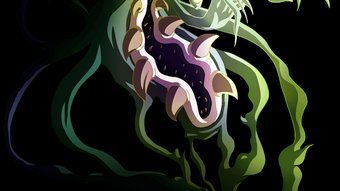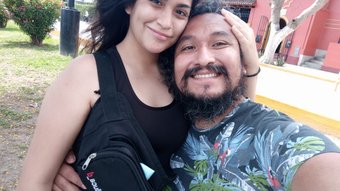[PART 1] Sarcofago Dionisiaco Con Pannychis [ITA/ENG] [3Speak]
4
About :

La versione Inglese dell'articolo è subito dopo quella Italiana- The English version of the article is immediately after the Italian version.



Ciao amici di Hive! Ho deciso di portare un altro mio lavoro, questa volta dal campo dell'archeologia! Spero vi piaccia! Per dare un ulteriore innovazione ai miei contenuti ho deciso di utilizzare 3Speak!
Se avete consigli sono ben accetti ;)
Buona lettura

MATERIA: marmo bianco.
MISURE: Altezza m 0.50; Lunghezza m 2.04; Larghezza m 0.66.
COLLOCAZIONI PRECEDENTI: Villa della Farnesina; poi Palazzo Farnese in Campo dei Fiori.
PROVIENZA: dal Giardino della Chiesa di San Marco.
STATO DI CONSERVAZIONE: la facciata anteriore presenta alcune schegge mancanti della cornice superiore. Il personaggio di sinistra del gruppo centrale è privo della gamba sinistra a partire dalla metà della coscia; Sul lato destro le due figure visibili davanti all’erma hanno perduto le corna e mostrano i volti danneggiati, mentre il fanciullo che li precede risulta privo della mano sinistra e parte del ramoscello che regge in grembo; dalla parte opposta la figura di spalle all’erma di Pan manca delle corna e delle dita della mano sinistra, che sono integrate in gesso. Il lato minore destro presenta scheggiature in entrambi i listelli e un grosso foro di scolo ai piedi della figura sulla destra; L’ altro lato breve, benché piuttosto corroso, presenta solo piccole schegge mancanti. In generale la superficie appare abrasa in diversi punti.
Lo spiccato carattere erotico dell’animata scena ambientata nell’atmosfera di un santuario agreste, raffigurata sulla fronte anteriore del sarcofago dionisiaco con Pannychis (l’orgia notturna di celebrazione dei culti misterici a cui partecipavano i componenti del corte di Dioniso) rappresenta senza dubbio una delle ragioni principali della costante ammirazione ricevuta da questo monumento fin dal Rinascimento da parte di studiosi e artisti, divenendo oggetto di una lunga e continuata tradizione grafica e a stampa a partire dalla fine del XV secolo. Si tratta infatti di un eloquente testimonianza del paganesimo, rimasta esposta presumibilmente già dal medioevo, nel giardino della chiesa di San Marco presso Palazzo Venezia, dove il sarcofago viene segnalato dagli artisti in un periodo che va dal ‘400 ai primi tre decenni del ‘500, tra questi artisti ricordiamo Amico Aspertini e Marcantonio Raimondi che lì lo videro e lo ritrassero numerose volte. In seguito se ne ritrova notizia nel libro di Ulisse Aldrovandi, nel quale il monumento viene ricordato come esistente presso i possedimenti Farnesiani di Trastevere, collocato insieme ad un altro sarcofago con Muse ai lati dell’ingresso del giardino grande, dove quindi dovette pervenire in un momento imprecisato, compreso tra il breve periodo che va dagli anni ’30 del 1500 al 1549-50, quando fu visto e descritto da Aldrovandi stesso.
«…Nel giardino del Reverendiβ. Farnese, che è al di là dal Tevere, al dritto del suo Palagio nuovo… Su l’entrare del giardino grāde si trova una antica pila, nella quale sono scolpite di mezo rilievo le nove Muse vestite; fra le quali due ne tengono una maschera per una: una tiene una testuggine, l’altra una palla in mano. Dall’altro canto si vede un’altra Pila, dove sono le feste di Bacco iscolpite: e tra l’altre cose vi si veggono molti Fauni e Satiri; & alcuni di loro hanno in mano le faci accese; due altri di loro conducono Sileno imbriaco, che fu colui che allevò Bacco: vi si vede medesimamente un Priapo, un che giace; un Satiro ch’esce d’una camera. Nel fronte di quella Pila di veggono due, che portano in una cestella un puttino: dall’altra parte sono due donne, una delle quali ha in mano un vasetto. Sotto queste pile si veggono scolpite fasci antichi, che solevano portar in Roma i Sergenti e ministri de’ Consoli. Il sarcofago con le nove Muse faceva da pendent a quello con la Pannychis ai lati dell’ingresso del giardino di Trastevere è quello che si trova attualmente nella corte dell’ala S-E di Palazzo Farnese in Campo dei Fiori…»
Ulisse Aldrovandi 1562, pp. 160-161
La ricostruzione delle successive vicende di conservazione del Sarcofago è resa difficoltosa dalla circostanza che all’interno degli inventari Farnesiani non si trova in nessun caso un’adeguata descrizione del tema raffigurato, rendendo complicata l’identificazione del pezzo. Senza dubbio tuttavia, tra la metà del XVI secolo ed i primi decenni del XVII secolo dovette subire uno spostamento dal giardino dei possidimenti Farnesiani di Trastevere, in quanto non sembra più rintracciabile in quel luogo a partire dall’inventario del 1644. Procedendo ad una cernita dei sarcofagi menzionati in questo inventario, l’ipotesi più attendibile è che vada riconosciuto nel pilo historiato ricoperto con un panno di tela, che viene menzionato all’interno della Sala delli Imperatori al piano nobile del palazzo di Campo di Fiori, in coppia con un altro sarcofago dionisiaco di dimensioni simili. Non stupisce d’altronde la decisione di tenere il rilievo occultato da un drappo oscuro, a causa del contenuto lascivo di alcuni particolari della scena, alla cui visione dovevano evidentemente essere ammessi soltanto visitatori selezionati. Tale sistemazione dovette durare per tutto il Settecento, come si evince dalla lettura degli inventari successivi, nei quali i due sarcofagi compaiono collocati nella sala uno di fronte all’altro sormontati da statuette con ai lati figure di cani accovacciati. Ritenuto dal Venuti un pezzo degno di essere spedito a Napoli, venne quindi trasportato senza restauri nel Museo della Fabbrica della Porcellana a Capodimonte e successivamente immesso nel Museo dei Vecchi Studi, dove figura tra le opere elencate nell’inventario del 1805, per poi essere definitivamente sistemato nel Gabinetto Segreto del Real Museo Borbonico.
Segue un elenco degli inventari Farnesiani relativi al Sarcofago Dionisiaco con Pannychis:
1642? Palazzo Farnese, nella Sala delle statue delli Imperatori. Un Pilo Istoriato ( Rausa 2007a, Documenti n.1, p. 44, n.27).
1644. Palazzo Farnese. Nella Sala delle Statue delli Imperatori. Un pilo historiato con piedistallo d’albuccio coperto di tela a modo di cassone di noce (Jestaz 1994, p.185, n.4498).
1697. Palazzo Farnese (DI, II, p.380).
1728-1734. Palazzo Farnese (Rausa 2007a, Documenti n.3, p.62, n.13).
1736. Palazzo Farnese. Nella Sala dell’Imperatori. Due Urne antiche con figure, et altro di basso rilievo (Rausa 2007a, Documenti n.4, p.69, n.103).
1767. Palazzo Farnese. Stanza contigua alli gabinetti. Due urne di marmo antiche, con bassi rilievi rappresentanti il trionfo di Bacco (DI, III, p.188).
1775 b. Palazzo Farnese. Ottava Stanza. Due Sarcofagi istoriati da capo e da piedi di detta stanza, sopra di uno sono due cani con statuette di marmo rosso; e sopra l’altro due cani, ed un putto che dorme a sedere ( DI, III, p.199).
1783-1786. Palazzo Farnese. Salone. Dirimpetto alla medesima fra le due finestre vi è un altro sarcofago cenerario lungo palmi nove, alto palmi due, con molte figure, che per la conservazione merita trasporto. Sopra di esso due cani giacenti con teste e gambe moderne di una mediocre scoltura. In mezzo dell’istessa vi è un oietoso amorino alto palmi due di pessima scoltura ( Menna 1974, p.273, nn.48-51.)
1796. Nuovo Museo e Fabbrica della porcellana di Napoli. Altro sarcofago con bassorilievo di un baccanale con Satiri, lungo palmi 7 ¾, alto palmi 1 11/12, grosso palmi 2 ½ - è di bella scultura, per il carattere ed espressione delle figure, e vi occorrono pochi tasselli per restaurarsi, ed esiste ivi (DI, I, p.206, n.390).
1805. Nuovo Museo dei Vecchi Studi di Napoli. Sarcofago rappresentante un baccanale, o misteri di Bacco; cioè Bacco sbarbato e vestito di veste talare, appoggiato a due Satiri, circondato d’altri Satiri, Amori, Baccanti e Satiresse, delle quali una dorme, altre carezzano erme con priapi etc. Lungo palmi 7 ¾, alto palmi 1 11/12. Largo palmi 2 ¼ . I due lati sono ornati di basso rilievi consimili. Bello, ed interessante - III (DI, IV, p.200, n.42).
1819. Real Museo Borbonico. Farnese. Sarcofago di marmo, lungo palmi otto, alto due palmi, e largo palmi due e mezzo. Esso è decorato di tre basso rilievi; il primo ch’è il più interessante è nella faccia principale e presenta una donnesca iniziazione dei famigerati misteri di Bacco, che passa fra tredici figure e due Erme di Pane. [ continua con la descrizione] Le due facce laterali presentano oggetti analoghi al già descritto [procede con la descrizione] (Inv. Arditi, n.613).
1842-1848. (Monumenti Farnesiani, II, n. inv. Gen. 24, n. progress.4)



Hello Hive friends! I have decided to bring you another work of mine, this time from the field of archaeology! I hope you enjoy it! To give my content a further innovation, I decided to use 3Speak!
If you have any advice, I welcome it ;)
Happy reading

MATERIAL: white marble.
MEASUREMENTS: Height m 0.50; Length m 2.04; Width m 0.66.
PREVIOUS LOCATIONS: Villa della Farnesina; then Palazzo Farnese in Campo dei Fiori.
PROPERTY: from the Garden of the Church of San Marco.
STATE OF CONSERVATION: The front facade has some splinters missing from the upper frame. The left figure of the central group is missing his left leg starting from the middle of the thigh; on the right side the two figures visible in front of the herma have lost their horns and show damaged faces, while the boy in front of them is missing his left hand and part of the twig he is holding in his lap; on the opposite side the figure with his back to the Pan herma is missing the horns and the fingers of his left hand, which are integrated in plaster. The smaller right side has chipping in both laths and a large drainage hole at the foot of the figure on the right; the other short side, although rather corroded, has only small chips missing. In general, the surface appears abraded in several places.
The strong erotic character of the animated scene set in the atmosphere of a rural sanctuary, depicted on the front of the Dionysian sarcophagus with Pannychis (the nocturnal orgy celebrating the mystery cults attended by members of the court of Dionysus) is undoubtedly one of the main reasons for the constant admiration this monument has received since the Renaissance by scholars and artists, becoming the subject of a long and continuous graphic and printed tradition from the end of the 15th century onwards. The sarcophagus is in fact an eloquent testimony to paganism, which has presumably been on display since the Middle Ages in the garden of St. Mark's Church near Palazzo Venezia, where the sarcophagus is mentioned by artists in a period ranging from the 15th century to the first three decades of the 16th century. Among these artists are Amico Aspertini and Marcantonio Raimondi, who saw and portrayed it there numerous times. Later, we find news of it in Ulisse Aldrovandi's book, in which the monument is mentioned as existing at the Farnesian estates in Trastevere, placed together with another sarcophagus with Muses on either side of the entrance to the large garden, where it must therefore have arrived at an unspecified time, between the brief period between the 1530s and 1549-50, when it was seen and described by Aldrovandi himself.
"...In the garden of the Reverendiβ. Farnese, which is on the other side of the Tiber, at the right side of his Palagio nuovo... On the entrance of the garden there is an ancient pile, in which the nine dressed Muses are carved in half relief; among which two hold a mask for one: one holds a tortoise, the other a ball in her hand. On the other side is another pile, where the feasts of Bacchus are sculpted: and among other things, many Fauns and Satyrs can be seen there; and some of them are holding burning fairies in their hands; two others are carrying Silenus the imbriacus, who was the one who raised Bacchus: there is also a Priapus, one who is lying, and a Satyr coming out of a chamber. In the front of that pile one sees two men carrying a cherub in a basket: on the other side are two women, one of whom is holding a vase. Under these piles are carved ancient fasces, which the sergeants and ministers of the consuls used to wear in Rome. The sarcophagus with the nine Muses was a pendant to the one with the Pannychis at the side of the entrance to the garden of Trastevere is the one that is now in the courtyard of the S-E wing of Palazzo Farnese in Campo dei Fiori..."
Ulisse Aldrovandi 1562, pp. 160-161
The reconstruction of the subsequent conservation history of the sarcophagus is made difficult by the fact that the Farnese inventories nowhere contain an adequate description of the theme depicted, making the identification of the piece complicated. Undoubtedly, however, it had to be moved from the garden of the Farnese estates in Trastevere between the mid-16th century and the first decades of the 17th century, as it no longer seems to be traceable there as of the inventory of 1644. Proceeding to a selection of the sarcophagi mentioned in this inventory, the most reliable hypothesis is that it should be recognised in the pilo historiato covered with a cloth, which is mentioned inside the Sala delli Imperatori on the piano nobile of the Campo di Fiori palace, paired with another Dionysian sarcophagus of similar size. Moreover, the decision to keep the relief concealed by a dark drape is not surprising due to the lascivious content of certain details of the scene, to which only selected visitors were evidently to be admitted. This arrangement must have lasted throughout the 18th century, as can be deduced from subsequent inventories, in which the two sarcophagi appear placed in the room facing each other surmounted by statuettes with figures of crouching dogs on either side. Considered by Venuti to be a piece worthy of being sent to Naples, it was then transported without restoration to the Museo della Fabbrica della Porcellana in Capodimonte and subsequently placed in the Museo dei Vecchi Studi, where it appears among the works listed in the inventory of 1805, before being definitively placed in the Gabinetto Segreto of the Real Museo Borbonico.
The following is a list of the Farnese inventories relating to the Dionysian Sarcophagus with Pannychis:
1642? Palazzo Farnese, in the Hall of the Statues of the Emperors. Un Pilo Istoriato ( Rausa 2007a, Documenti n.1, p. 44, n.27).
- Farnese Palace. In the Hall of the Statues of the Emperors. Un pilo historiato con piedistallo d'albuccio coperto di tela a modo di cassone di noce (Jestaz 1994, p.185, n.4498).
- Palazzo Farnese (DI, II, p.380).
1728-1734. Palazzo Farnese (Rausa 2007a, Documents no. 3, p.62, no. 13). - Farnese Palace. In the Hall of the Emperors. Two ancient urns with figures, and other of low relief (Rausa 2007a, Documenti n.4, p.69, n.103).
- Palazzo Farnese. Room adjoining the cabinets. Two antique marble urns, with low reliefs representing the triumph of Bacchus (DI, III, p.188).
1775 b. Farnese Palace. Eighth Room. Two historiated sarcophagi from head and foot of the said room, above one are two dogs with red marble statuettes; and above the other two dogs, and a putto sleeping and sitting (DI, III, p.199).
1783-1786. Farnese Palace. Salone. Opposite it between the two windows is another cinerary sarcophagus nine palms long and two palms high, with many figures, which deserves to be transported for its preservation. Above it are two lying dogs with modern heads and legs of a mediocre sculpture. In the middle of the same there is a cherub, two palms high, of very poor sculpture (Menna 1974, p.273, nos. 48-51). - New Porcelain Museum and Factory in Naples. Another sarcophagus with a bas-relief of a Bacchanal with Satyrs, 7 ¾ palms long, 1 11/12 palms high, 2 ½ palms thick - it is of beautiful sculpture, for the character and expression of the figures, and it needs only a few pieces to be restored, and exists there (DI, I, p.206, n.390).
- New Museum of Old Naples. A sarcophagus representing a Bacchanal, or the Mysteries of Bacchus; that is, Bacchus bearded and dressed in a cassock, leaning on two Satyrs, surrounded by other Satyrs, Lovers, Bacchae and Satyrs, one of whom is sleeping, the others caressing herms with priapi etc. Length 7 ¾ palms, height 1 11/12 palms. Width 2 ¼ palms. The two sides are decorated with similar low reliefs. Beautiful, and interesting - III (DI, IV, p.200, no.42).
- Royal Bourbon Museum. Farnese. Marble sarcophagus, eight palms long, two palms high, and two and a half palms wide. It is decorated with three bas-reliefs; the first, which is the most interesting, is on the main face and depicts a female initiation into the infamous mysteries of Bacchus, passing between thirteen figures and two Erme di Pane. [ continues with description] The two side faces present similar objects to the one already described [continues with description] (Inv. Arditi, no. 613).
1842-1848. (Monumenti Farnesiani, II, Inv. no. Gen. 24, no. progress.4)
Tags :
Their limit for today is $0!
More Videos
@tipu: 0.9119
@discovery-it: 0.2622
@mad-runner: 0.0890
@libertycrypto27: 0.0533
@boatymcboatface: 0.0450
@nautilus-up: 0.0369
@armandosodano: 0.0359
@meppij: 0.0277





























Comments:
Reply:
To comment on this video please connect a HIVE account to your profile: Connect HIVE Account